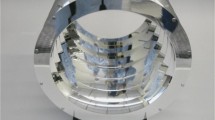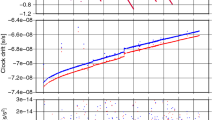Abstract
The Lunar Orbiter Laser Altimeter (LOLA) is an instrument on the payload of NASA’s Lunar Reconnaissance Orbiter spacecraft (LRO) (Chin et al., in Space Sci. Rev. 129:391–419, 2007). The instrument is designed to measure the shape of the Moon by measuring precisely the range from the spacecraft to the lunar surface, and incorporating precision orbit determination of LRO, referencing surface ranges to the Moon’s center of mass. LOLA has 5 beams and operates at 28 Hz, with a nominal accuracy of 10 cm. Its primary objective is to produce a global geodetic grid for the Moon to which all other observations can be precisely referenced.
Similar content being viewed by others
References
J.B. Abshire , Geoscience Laser Altimeter System (GLAS) in the ICESat mission: On-orbit measurement performance. Geophys. Res. Lett. 43, L21S02 (2005)
H. Araki , Lunar global shape and polar topography derived from Kaguya-LALT laser altimetry. Science 323, 897–900 (2009)
B.A. Archinal, et al., U.S. Geological Survey Open File Report 2006-1367, 21 pp., 2006. pubs.usgs.gov/of/2006/1367/
J.F. Cavanaugh , The Mercury Laser Altimeter instrument for the MESSENGER mission. Space Sci. Rev. 131, 451–480 (2007)
G. Chin , Lunar Reconnaissance Orbiter overview: The instrument suite and mission. Space Sci. Rev. 129, 391–419 (2007). doi:10.10007/s11214-007-9153-y
A.C. Cook , Lunar polar topography derived from Clementine stereoimages. J. Geophys. Res. 105, 12,023–12,033 (2000)
J.O. Dickey , Lunar laser ranging: A continuing legacy of the Apollo program. Science 265, 482–490 (1994)
W.M. Folkner, J.G. Williams, Planetary Ephemeris DE421 for Phoenix Navigation (Jet Propulsion Laboratory, Pasadena, 2008)
H. Frey et al., Ancient lowlands on Mars. Geophys. Res. Lett. 29 (2002). doi:10.1029/2001GL013832
C.S. Gardner, Target signatures for laser altimeters: an analysis. Appl. Opt. 21, 448–453 (1982)
S. Goossens, K. Matsumoto, Lunar degree 2 potential Love number determination from satellite tracking data. Geophys. Res. Lett. 35 (2008). doi:10.1029/2007GL031960
W.M. Hartmann, Lunar cratering chronology. Icarus 13, 299–301 (1970)
W.M. Hartmann, Moon: Origin and evolution of multi-ring basins. Moon 3, 3–78 (1971)
J.A. Kamalakar , Lunar ranging instrument for Chandrayaan-1. J. Earth Syst. Sci. 114, 725–731 (2005)
A.S. Konopliv , Recent gravity models as a result of the Lunar Prospector mission. Icarus 150, 1–18 (2001)
H.J. Melosh, Impact Cratering: A Geologic Process (Oxford University Press, New York, 1989). 245 pp.
G.A. Neumann , The crossover analysis of MOLA altimetric data. J. Geophys. Res. 106, 23,753–23,768 (2001)
S. Nozette , The Clementine mission to the Moon: Scientific overview. Science 266, 1835–1839 (1994)
D.E. Pavlis et al., GEODYN Operations Manuals. Raytheon ITTS Contractor Report, Lanham, MD, 2001
H. Qian, Topography of the Moon from the Chang’e Laser Altimetry Data, 2008
W. Quaide, Rilles, ridges and domes—Clues to maria history. Icarus 4, 374–389 (1965)
L. Ramos-Izquierdo et al., The Lunar Orbiter Laser Altimeter (LOLA) optical subsystem, 2009
H. Riris et al., LOLA Calibration Report. NASA/Goddard Space Flight Center, Greenbelt, MD, 2008
M.S. Robinson et al., The Lunar Reconnaissance Orbiter Camera (LROC). Space Sci. Rev. (2009, this issue)
D.D. Rowlands , The use of laser altimetry in the orbit and attitude determination of Mars Global Surveyor. Geophys. Res. Lett. 26, 1191–1194 (1999)
R.A. Schultz , Igneous dikes on Mars revealed by Mars Orbiter Laser Altimeter topography. Geol. Soc. Am. Bull. 32, 889–892 (2004)
B.E. Schutz, Laser altimetry and LIDAR from ICESat/GLAS. IEEE Geosci. Remote Sens. 3, 1016–1019 (2001)
D.E. Smith , Topography of the Moon from the Clementine LIDAR. J. Geophys. Res. 102, 1591–1611 (1997)
D.E. Smith , The global topography of Mars and implications for surface evolution. Science 284, 1495–1503 (1999)
D.E. Smith , Mars Orbiter Laser Altimeter: Experiment summary after the first year of global mapping of Mars. J. Geophys. Res. 106, 23,689–23,722 (2001)
L. Soderblom, A model for small-impact erosion applied to the lunar surface. J. Geophys. Res. 75, 2655–2661 (1970)
P.D. Spudis , Ancient multiring basins on the Moon revealed by Clementine laser altimetry. Science 266, 1848–1851 (1994)
X. Sun et al., Radiometry measurements of Mars at 1064 nm using the Mars Orbiter Laser Altimeter. EOS Trans. Am. Geophys. Un. 82, 2001
U.S. Geological Survey, Color-coded topography and shaded relief map of the lunar near side and far side hemispheres. Flagstaff, AZ, 2002, pp. I-2769
M.A. Wieczorek, Gravity and topography of the terrestrial planets. Treatise Geophys. 10, 165–206 (2007)
M.T. Zuber , The Mars Observer Laser Altimeter investigation. J. Geophys. Res. 97, 7781–7797 (1992)
M.T. Zuber , The shape and internal structure of the Moon from the Clementine mission. Science 266, 1839–1843 (1994)
M.T. Zuber , Outstanding questions on the internal structure and thermal evolution of the Moon and future prospects from the GRAIL mission. Lunar Planet. Sci. Conf. XXXIX, #1074 (2008a)
M.T. Zuber , Laser altimeter observations from MESSENGER’s first Mercury flyby. Science 321, 77–79 (2008b)
M.T. Zuber et al., The Lunar Reconnaissance Orbiter laser ranging investigation. Space Sci. Rev. (2009, this issue)
Author information
Authors and Affiliations
Corresponding author
Rights and permissions
About this article
Cite this article
Smith, D.E., Zuber, M.T., Jackson, G.B. et al. The Lunar Orbiter Laser Altimeter Investigation on the Lunar Reconnaissance Orbiter Mission. Space Sci Rev 150, 209–241 (2010). https://doi.org/10.1007/s11214-009-9512-y
Received:
Accepted:
Published:
Issue Date:
DOI: https://doi.org/10.1007/s11214-009-9512-y




